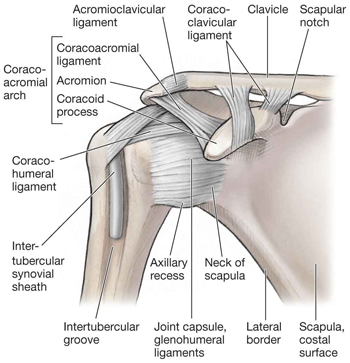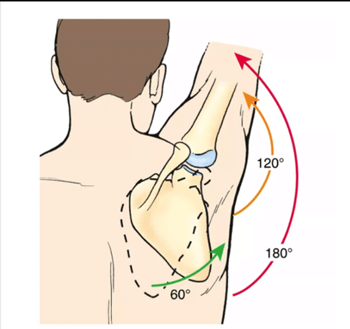The scapula is a large triangular-shaped bone that lies in the upper back.
It is also known as the shoulder blade.
How the scapula is connected to the rest of the skeleton?
The scapula, compared to other body bonds, is connected to the main skeleton, a series of ligaments that sit only on one side and extremity of it.
The ligaments are:
- transverse scapular ligament;
- coracoacromial ligament;
- coracoclavicular ligament;
- coracohumeral ligament;
- glenohumeral ligaments;
- acromioclavicular ligament.

That’s for is also called a “floating” bond.
So to be more specific, as any ligaments do not connect the medial or inferior/lateral borders to any other bond structure, the scapula is subjective to the muscle’s force.
Indeed, the shoulder blades of an individual often don’t look the same.
What do I mean by that?
Well, starting from the fact that one body side is more dominant than the other.
Take, for example, an office worker.
Despite being seated or at a standing desk, most of the time, the dominant hand will be the one using the mouse, right?
Where the non-dominant hand will be the one mainly sitting on the keyboard.
Now, the hand that moves the mouse is less lucky to leave its position and do other tasks.
As the mouse is in constant action, that hand is in continuous movement, yes, but it doesn’t go that far.
Indeed, the non-dominant hand would move more freely as it is not always typing.
Said so, the arm controls that hand per consequence, moving less.
Due to the poor ergonomics of many desks, that arm is seated on a narrow-angle, so the elbow is constantly flexed.
All this micro action, multiplied for days, weeks, months and years, brings the scapula to the mercy of the muscle force.
As per this example, the bicep force.
We did mention just now that the elbow is constantly flexed, right?
So the Bicep, the primary elbow flexor, will be constantly under tension.
Now, looking at the bicep origin, we find that:
- The short head originates in the Apex of the Coracoid process of the scapula
- The long head originates in the Supraglenoid tubercle of the scapula
This is then how the scapula gets constantly pulled from this muscle.
Then obviously, there are other muscles to play a contro-part.
In this case, we can think of the lower trap and the lat dorsi, which inserts at the inferior angle of the shoulder blade, so on the opposite side of where the bicep pulls from.
But if those muscles are not trained to compensate for the constant pulling force of the flexed arm, then the scapula will be tipped out.
What is a tipped Scapula?
For “tipped scapula, ” we refer to a scapula with a prominent inferior corner.
On the other hand, especially for the coracoid process, there is more muscle originating from that area, such as the Pectoralis Minor and the Coracoid Muscle.
Now, after analysing how muscle tension can move the scapula around, we can talk about other scapula facts.
So a Scapula should sit with the inferior angle at the high of T7 (vertebrae).
But that’s not always the case.
So we can have a “depressed” scapula that can sit lower than T7 or an “elevated” scapula that can sit above T7.
Lev scapulae and lower trap are the muscles responsible for a depressed or elevated scapula.
It all depends on the tightness or laxity of the muscles.
Furthermore, we can have a “winged” scapula. Therefore, the medial border is visibly protracted.
For this case, is Serratus Anterior responsible for the winged shoulder blade.
As this muscle gets loose, the shoulder blade escapes the rib cage.
On the other hand, when we look at a scapula, we also see if it is “downwardly rotated” or “upwardly rotated”.

Preferably we would like to see the shoulder blade being upwardly rotated.
That means having the superior angle closer to the spine and the inferior angle further away.
Why so is because when we elevate the arm, either in flexion or in adduction (flexion on sidewise), the scapula is ready to follow the humerus.
In this post, I already talked about the muscles involved in the scapula rotation.
How can massage help with shoulder pain?
We always have to look at the presentation regarding massage and treatment from which a shoulder can benefit.
A Myotherapy, Remedial Massage or a Thai Massage is good to:
- improve mobility;
- reduce tensions;
- alleviate trigger points;
- rehabilitating the shoulder.
MLD, on the other hand, is more recommended for
- fracture;
- inflammation of the muscle surrounding the shoulder;
- pre-post operation;
- swelling;
- skin rash on the shoulder area.
In conclusion, if your shoulder needs some work done, your next massage is a click away.